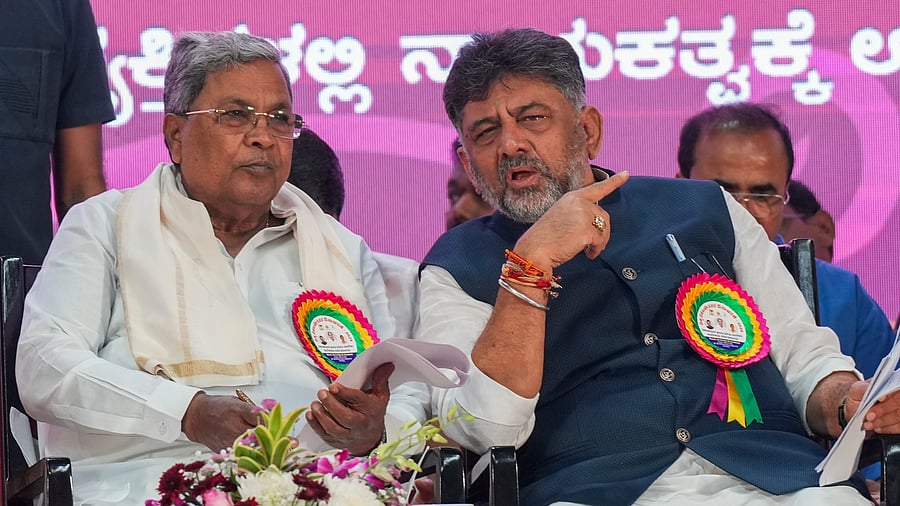
Karnataka Chief Minister Siddaramaiah and Deputy Chief Minister D K Shivakumar
Credit: PTI File Photo
It has happened as anticipated. When assertive Congress leader D K Shivakumar was appointed as the Karnataka Pradesh Congress Committee (KPCC) president and Siddaramaiah, an `Ahinda’ leader, was chosen to lead the 2023 Assembly elections campaign, many feared
potential turmoil if the party came to power. It did, in a telling fashion, and the brewing tensions between the two power centres—Siddaramaiah and DKS—became evident during the tussle over the chief ministerial post.
Less than two years into its tenure, factionalism in the state government shows the signs of reaching a climax. A glimpse of it was played out in Bengaluru over the last two weeks, forcing the party high command to intervene. However, this did little to ease tensions as demands for power sharing and calls to replace DKS as KPCC chief gained momentum.
The crux of the discord is the power transfer issue—the unofficial understanding that DKS would be the CM after Siddaramaiah completes 30 months in office in December 2025. However, there is no clarity over this—whether there was an agreement at the time of making Siddaramaiah the CM or not. For fear of triggering intense group war, the high command, Siddaramaiah and DKS have maintained silence on this issue.
In an indirect move against DKS, party members have also called for implementing the Udaipur resolution of the ‘one person, one post’ formula. DKS currently wears many hats: KPCC president, deputy CM, water resources minister, and Bengaluru development minister. Relinquishing the party chief position will leave him weaker. DKS and the high command, which has a soft corner for him, know this well. If the party leadership takes this up, questions will arise regarding the party’s national president himself! Mallikarjun Kharge too holds more than one post—
he is also Leader of the Opposition in Rajya Sabha.
For now, Siddaramaiah appears to be on a strong wicket. The second-time CM enjoys strong support from Ahinda (Kannada acronym for Adivasi, backwards and Dalits) MLAs, as well as some Lingayat and Vokkaliga legislators. If power-sharing is to occur, Siddaramaiah is likely to set
the terms.
The most vocal critics of DKS are all senior ministers who belong to the Scheduled Caste and Scheduled Tribe groups: G Parameshwara and H C Mahadevappa, and K N Rajanna and Satish Jarkiholi, respectively. Jarkiholi, from a powerful political family in Belagavi, recently hosted a dinner attended by Siddaramaiah and other Congress MLAs. The group is seething with anger that DKS prevailed on the high command to stop a dinner meeting of Dalit leaders to be hosted by Parameshwara, even questioning if the high command was `anti-Dalit’. As regards the Vokkaliga strongman, he was upset as the CM too attended the Jarkiholi dinner. The dinner fuelled reports of fresh efforts to clip DKS’s wings.
Siddaramaiah has already hinted at retirement and said he will not be in electoral politics henceforth. Hence, his followers are involved in cementing their own places in the party and are looking to emerge as leaders in their own right. Also, the CM’s confidants are said to be of the view that the power that the Dalits-backwards have secured should not be squandered allowing a member from a forward community to grab it. As for DKS, he is completely dependent on the high command—in other words, Sonia and Rahul Gandhi—to be made CM.
Historical precedents in Congress suggest that power struggles within the party are nothing new. In the 1990s, power shifted from Lingayat leader Veerendra Patil to S Bangarappa, representing backward communities, and later to M Veerappa Moily, another backward, in 1992. Also, it is not that the one with the backing of the majority of MLAs will get to be the CM. In 1990, K H Patil (father of current minister H K Patil) was said to enjoy majority support of Congress MLAs, but the high command favoured Bangarappa. When he was removed, it was S M Krishna, who had majority support, but the high command favoured Moily. But in 2023, it was Siddaramaiah, a backward, who enjoyed majority support, and DKS knew it well. But DKS also knew if he bargained hard, he may get what he wanted later. Parameshwara and Jarkiholi have realised this too.
The party’s and the state’s record with the power-sharing formula is also poor. In Rajasthan and Chhattisgarh in 2023, promises to hand over the chief ministerial position to Sachin Pilot and T S Singhdeo, respectively, were never fulfilled as the then CMs, Ashok Gehlot and Bhupesh Bhagel, respectively, refused to vacate the chair. Similarly, in Karnataka, H D Kumaraswamy refused to honour an open agreement to transfer power to B S Yediyurappa in 2007.
The high command is wary of removing Siddaramaiah due to his strong Ahinda backing. Forcibly replacing him with DKS risks alienating Dalit and backward-class voters, akin to how Lingayats turned against the Congress in 1990 after Veerendra Patil was unceremoniously removed as CM. The Lingayat votes later shifted to the BJP. So, the leadership favours a smooth transfer of power.
Amid intensifying infighting, governance in Karnataka has suffered. Frequent discussions about power transfer, factional meetings, and corruption allegations—including the alleged MUDA scam—among other issues have shifted the government’s attention away from administration. It is time the Siddaramaiah dispensation and the party put petty politics aside and focused on getting the administration back on track.
(The writer is a senior journalist)
Disclaimer: The views expressed above are the author's own. They do not necessarily reflect the views of DH.
